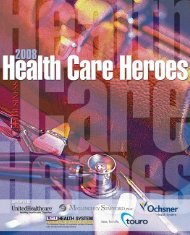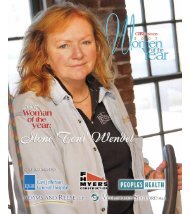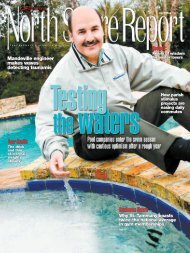We salute those who - New Orleans City Business
We salute those who - New Orleans City Business
We salute those who - New Orleans City Business
You also want an ePaper? Increase the reach of your titles
YUMPU automatically turns print PDFs into web optimized ePapers that Google loves.
NURSERosaBustamante-ForestPosition: program director and nurse manager, March of Dimes,Daughters of Charity Services of <strong>New</strong> <strong>Orleans</strong>Age: 55Family: husband, Larry; children, Geoffrey, 32, Lauren, 29, Rafael, 23Education: bachelor’s degree in nursing, Vanderbilt University; master’sdegree in public health, Tulane University; master’s degree in nursing,Louisiana State University Health Sciences Center School of NursingNorma’s story resembled that of 90 percent of the lowincomemigrant and mostly Hispanic expectant mothersRosa Bustamante-Forest has treated during the past twoyears on the mobile health unit she directs.“I was just there for her,” Bustamante-Forest said. “Assoon as I met Norma, I knew I’d done the right thing.”Bustamante-Forest is referring to having left a 25-yearcareer in academia to return to patient care. She started in thenursing field 34 years ago in a hospital maternity ward.Norma, a pseudonym, was pregnant, suffering from a historyof child abuse, incest and rape, and worried about thehealth of the two young daughters she’d left behind in ElSalvador with her mother. Norma worked in <strong>New</strong> <strong>Orleans</strong>,sending what little money she could to her mother, daughtersRosa Bustamante-Forestoffers health advice to patientSantos Martinez at the Marchof Dimes Mom and BabyMobile Health Center.and six younger siblings at home.“Emotionally and spiritually, she was broken,”Bustamante-Forest said of Norma. “Her physical aches andpains were really a manifestation of her broken spirit andemotional pain."A native El Salvadoran herself, Bustamante-Forest spokeNorma’s language and understood the struggles growing upimpoverished in the Central American country, althoughtheir childhoods were different.Norma gave birth to a healthy child, but her stresses continuedthrough unemployment and having to sleep on agarage floor with her husband and newborn.Bustamante-Forest gives kudos to her three-member crew,including Shannon Psingstag, nurse-midwife, LillieAcezedothe medical assistant and office manager, and healthpromoter Collying Salinas, <strong>who</strong>, along with the obstetricsgynecologyunit at Louisiana State University MedicalCenter, gave Norma all the help she needed.As Norma rebounded, she proudly told Bustamante-Forest of the flea market booth she was able to rent on the<strong>We</strong>st Bank, selling odds and ends.“Without us,” Bustamante-Forest said, “I think Normaprobably would not have received care.”•— Diana Chandlerphoto by Tracie Morris Schaeferphoto by Frank AymamiNURSECheryl CarterPosition: emergency department director, East Jefferson General HospitalAge: 54Family: husband, David; children, Brad Vandevender, 35, Dana Kelley, 28, Brandon Kelley, 26Education: associate’s degree in nursing, Gulf Coast Community College; bachelor’s degree inhealth arts, St. Francis UniversityAs director of East Jefferson GeneralHospital’s emergency department,Cheryl Carter sees up close the traumas andtriumphs of life — and she likes it that way.“This is an area of the hospital that hasquick rewards and quick turnarounds,” saidCarter, <strong>who</strong> has been with EJGH since theearly 1990s. “Someone may come in <strong>who</strong> is atdeath’s door, and the next day you see that thatperson survived and realize it is most likelybecause of the things that were done by ourteam in this department.”Overseeing a staff of about 80, Carter hasplayed a crucial role in developing the hospital’spsychiatric emergency department.“<strong>We</strong> partnered with our psych unit and nowactually have psych nurses <strong>who</strong> live in the emergencydepartment,” Carter said. “They are ableto interview patients and start therapeutic interactionsand, because of their perspective andtraining,have a lot of resources at their fingertipsthat the emergency nurses may not have.”That perspective means that an emergencyroom patient <strong>who</strong> may have more challengesthan just physical problems is treated at manylevels, Carter said.Because Carter has emerged as a mentor toher fellow nurses as well as an expert <strong>who</strong>keeps up with regulatory issues, she has frequentlybeen thrust into leadership positions,most recently serving as chairwoman for theEmergency Nurses Association’s local chapter.Last summer, Carter led an outreach programfor two hospitals in Cedar Rapids, Iowa,as floods were ravaging the region.“The idea was to present ourselves as livingtestimony to the fact you can be hit by a hugeflood and still live,” Carter said, referring to thework she and members of her staff at EJGHdid for some 12 straight days after Katrina hit<strong>New</strong> <strong>Orleans</strong>.Bringing with them care packages full of<strong>New</strong> <strong>Orleans</strong> food, Carter governed the teamwith a guiding principle.“When you are involved in the huge job ofcleaning up after a flood, just having one mealyou don’t have to cook is a big plus.”•— Garry Boulard<strong>New</strong> <strong>Orleans</strong> <strong>City</strong><strong>Business</strong> — May 25, 2009 15
















